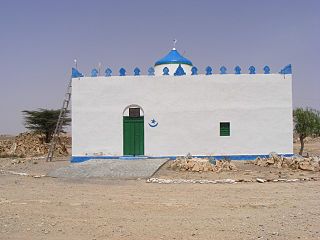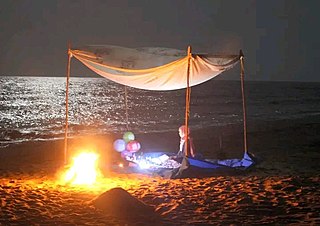
Upwelling is an oceanographic phenomenon that involves wind-driven motion of dense, cooler, and usually nutrient-rich water from deep water towards the ocean surface. It replaces the warmer and usually nutrient-depleted surface water. The nutrient-rich upwelled water stimulates the growth and reproduction of primary producers such as phytoplankton. The biomass of phytoplankton and the presence of cool water in those regions allow upwelling zones to be identified by cool sea surface temperatures (SST) and high concentrations of chlorophyll a.

Sanag is an administrative region (gobol) in north eastern Somaliland. Sanaag has a long coastline facing the Gulf of Aden to the north, and is bordered by the region of Sahil to the west, Sool to the south and Somalia to the east. The region is disputed by the self-declared Republic of Somaliland and Puntland, a Federal Member State of Somalia. Its capital city is Erigavo. Sanaag is the largest region of Somaliland, accounting for 35% of Somaliland's total land area.

The family Procellariidae is a group of seabirds that comprises the fulmarine petrels, the gadfly petrels, the diving petrels, the prions, and the shearwaters. This family is part of the bird order Procellariiformes, which also includes the albatrosses and the storm petrels.

The sooty tern is a seabird in the family Laridae. It is a bird of the tropical oceans, returning to land only to breed on islands throughout the equatorial zone.

The masked booby, also called the masked gannet or the blue-faced booby, is a large seabird of the booby and gannet family, Sulidae. First described by the French naturalist René-Primevère Lesson in 1831, the masked booby is one of six species of booby in the genus Sula. It has a typical sulid body shape, with a long pointed yellowish bill, long neck, aerodynamic body, long slender wings and pointed tail. The adult is bright white with black wings, a black tail and a dark face mask; at 75–85 cm (30–33 in) long, it is the largest species of booby. The sexes have similar plumage. This species ranges across tropical oceans, except in the eastern Atlantic and eastern Pacific. In the latter, it is replaced by the Nazca booby, which was formerly regarded as a subspecies of masked booby.

Laas Geel, also spelled Laas Gaal, are cave formations on the rural outskirts of Hargeisa, Somaliland, situated in the Maroodi Jeex region of the country. They contain some of the earliest known cave paintings of domesticated cattle, which some argue may represent domesticated African aurochs, in the Horn of Africa. Laas Geel's rock art is estimated to date to circa 3,500-2,500 BCE.

Maydh is an ancient port city in the eastern Sanaag region of Somaliland.

Haylan, is a town in the eastern Sanaag region of Somaliland.

Heis is a historic coastal town located in the Sanaag region of Somaliland. The town was important for trade and communication with the Somali interior and was used to export frankincense to Arabia.

El Ayo, also known as El Ayum, is a coastal town in the eastern Sanaag region of Somalia. There is a base of the Puntland Maritime Police Force, which is effectively controlled by Puntland.
Tourism in Somalia is regulated by the Federal Government of Somalia's Ministry of Tourism. The industry was traditionally noted for its numerous historical sites, beaches, waterfalls, mountain ranges and national parks. After the start of the civil war in the early 1990s, the Tourism Ministry shut down operations. It was re-established in the 2000s, and once again oversees the national tourist industry. The Mogadishu-based Somali Tourism Association (SOMTA) provides on-the-ground consulting services.
Tourism in Somaliland is regulated by the Somaliland's Ministry of Tourism.

The Sa'ad ad-Din Islands, also Romanized as Sa'ad-ed-din and known as the Zeila Archipelago, are a group of islands off the northwestern coast of Somaliland. They are situated near the ancient city of Zeila.

El-Sheikh is a coastal settlement in the western edge of the Sahil region of Somaliland.

The Somali montane xeric shrublands is a desert and xeric scrubland ecoregion in Somalia. The ecoregion lies in the rugged Karkaar Mountains, which run parallel and close to Somalia's northern coast on the Gulf of Aden, and follows coast from Cape Guardafui south to Eyl on the Arabian Sea.

Siyara was a historic coastal settlement and fort located in the Sahil region of Somaliland. It served as the first capital of the Adal Sultanate following the Muslim resurgence spearheaded by Sabr ad-Din II.

El-Darad was a historic coastal settlement and fort located in the Sahil region of Somaliland.

Sheikh Ishaaq bin Ahmed bin Muhammad bin al-Hussein al-Hashimi, more commonly known as Sheikh Ishaaq or Sheikh Isaaq was an Arabian sheikh and the alleged Sayyid forefather of the Isaaq Somali clan-family in the Horn of Africa, whose traditional territory is wide and densely populated.
The Sanbur is a major clan of the wider Isaaq clan family. Its members form part of the larger Habr Habusheed confederation along with the Habr Je'lo, Ibran and Tol Je'lo clans. Politically however, the Sanbur fall under the Habr Je'lo clan.
















